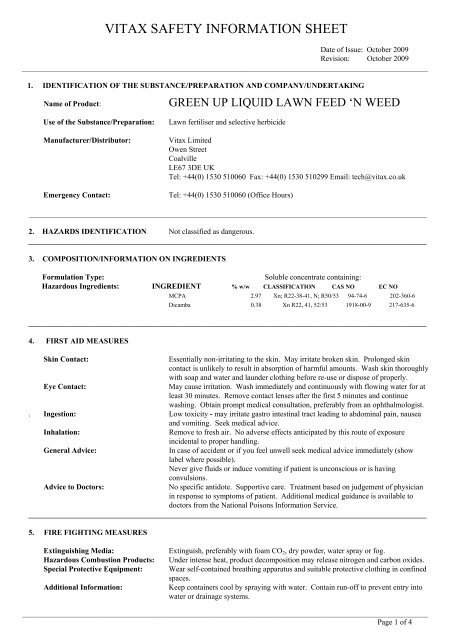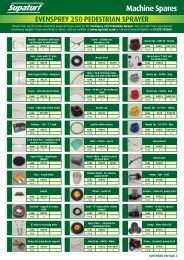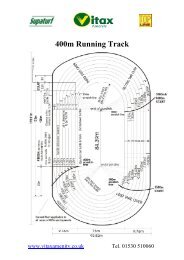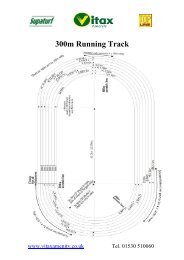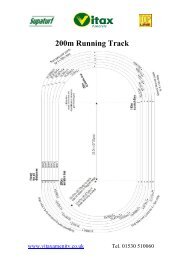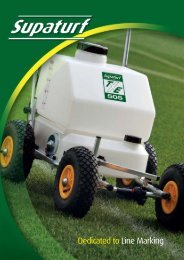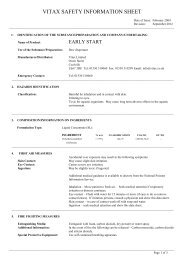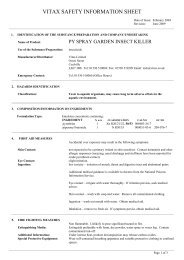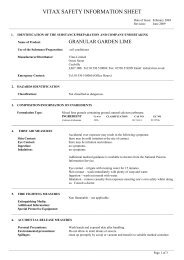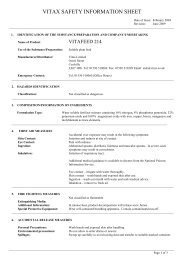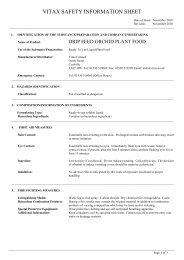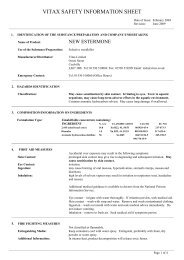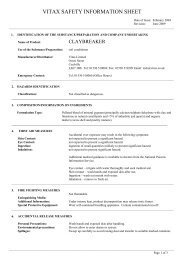Green Up Liquid Feed & Weed - Vitax
Green Up Liquid Feed & Weed - Vitax
Green Up Liquid Feed & Weed - Vitax
You also want an ePaper? Increase the reach of your titles
YUMPU automatically turns print PDFs into web optimized ePapers that Google loves.
VITAX SAFETY INFORMATION SHEET<br />
Date of Issue: October 2009<br />
Revision: October 2009<br />
__________________________________________________________________________________________________________<br />
1. IDENTIFICATION OF THE SUBSTANCE/PREPARATION AND COMPANY/UNDERTAKING<br />
Name of Product: GREEN UP LIQUID LAWN FEED ‘N WEED<br />
Use of the Substance/Preparation: Lawn fertiliser and selective herbicide<br />
Manufacturer/Distributor: <strong>Vitax</strong> Limited<br />
Owen Street<br />
Coalville<br />
LE67 3DE UK<br />
Tel: +44(0) 1530 510060 Fax: +44(0) 1530 510299 Email: tech@vitax.co.uk<br />
Emergency Contact: Tel: +44(0) 1530 510060 (Office Hours)<br />
________________________________________________________________________________________________________<br />
2. HAZARDS IDENTIFICATION Not classified as dangerous.<br />
________________________________________________________________________________________________________<br />
3. COMPOSITION/INFORMATION ON INGREDIENTS<br />
Formulation Type: Soluble concentrate containing:<br />
Hazardous Ingredients: INGREDIENT % w/w CLASSIFICATION CAS NO EC NO<br />
MCPA 2.97 Xn; R22-38-41, N; R50/53 94-74-6 202-360-6<br />
Dicamba 0.38 Xn R22, 41, 52/53 1918-00-9 217-635-6<br />
________________________________________________________________________________________________________<br />
4. FIRST AID MEASURES<br />
Skin Contact: Essentially non-irritating to the skin. May irritate broken skin. Prolonged skin<br />
contact is unlikely to result in absorption of harmful amounts. Wash skin thoroughly<br />
with soap and water and launder clothing before re-use or dispose of properly.<br />
Eye Contact: May cause irritation. Wash immediately and continuously with flowing water for at<br />
least 30 minutes. Remove contact lenses after the first 5 minutes and continue<br />
washing. Obtain prompt medical consultation, preferably from an ophthalmologist.<br />
. Ingestion: Low toxicity - may irritate gastro intestinal tract leading to abdominal pain, nausea<br />
and vomiting. Seek medical advice.<br />
Inhalation: Remove to fresh air. No adverse effects anticipated by this route of exposure<br />
incidental to proper handling.<br />
General Advice: In case of accident or if you feel unwell seek medical advice immediately (show<br />
label where possible).<br />
Never give fluids or induce vomiting if patient is unconscious or is having<br />
convulsions.<br />
Advice to Doctors: No specific antidote. Supportive care. Treatment based on judgement of physician<br />
in response to symptoms of patient. Additional medical guidance is available to<br />
doctors from the National Poisons Information Service.<br />
________________________________________________________________________________________________________<br />
5. FIRE FIGHTING MEASURES<br />
Extinguishing Media: Extinguish, preferably with foam CO2, dry powder, water spray or fog.<br />
Hazardous Combustion Products: Under intense heat, product decomposition may release nitrogen and carbon oxides.<br />
Special Protective Equipment: Wear self-contained breathing apparatus and suitable protective clothing in confined<br />
spaces.<br />
Additional Information: Keep containers cool by spraying with water. Contain run-off to prevent entry into<br />
water or drainage systems.<br />
__________________________________________________________________________________________________________<br />
Page 1 of 4
VITAX SAFETY INFORMATION SHEET<br />
Date of Issue: October 2009<br />
Revision: October 2009<br />
__________________________________________________________________________________________________________<br />
6. ACCIDENTAL RELEASE MEASURES<br />
Personal Precautions: Do not eat, drink or smoke. Wash hands and exposed skin after handling.<br />
Environmental precautions: Report to local water plc immediately if spillage enters drains and the Environment<br />
Agency or Scottish Environment Protection Agency if it enters surface or ground<br />
waters.<br />
Spillages: Soak up with absorbent material such as sand. Transfer to suitable marked<br />
container and keep safe before disposal.<br />
________________________________________________________________________________________________________<br />
7. HANDLING & STORAGE<br />
Handling: Do not block stack pallets. Use good personal hygiene. Do not consume or store<br />
food in the work area. Wash hands and exposed skin before eating, drinking or<br />
smoking and after work. Avoid contact with eyes and skin.<br />
Storage: Product should be stored in compliance with local regulations. Store in a cool, dry,<br />
well ventilated place in the original container. Protect from excessive heat and cold.<br />
Do not store near food, drink, animal feeding stuffs, pharmaceuticals, cosmetics or<br />
fertilisers. Keep out of reach of children.<br />
_________________________________________________________________________________________________________<br />
8. EXPOSURE CONTROLS/ PERSONAL PROTECTION<br />
Exposure guidelines: MCPA: IHG is 5mg/m 3 .<br />
Dicamba: None assigned.<br />
Engineering controls: Good general ventilation should be sufficient for most conditions. Local exhaust<br />
ventilation may be necessary for some operations.<br />
Respiratory protection: When airborne exposure guidelines and/or comfort levels may be exceeded, use an<br />
approved air purifying respirator. For emergency conditions, use an approved positive<br />
pressure self contained breathing apparatus.<br />
Hand/skin protection: Wear clean, long sleeved, body covering clothing. Use gloves chemicals resistant to<br />
this material when prolonged or frequently repeated contact could occur. For<br />
emergency conditions: Use protective clothing impervious to this material.<br />
Eye/face protection: Use chemical goggles.<br />
_______________________________________________________________________________________________________<br />
9. PHYSICAL & CHEMICAL Appearance brown aqueous solution<br />
PROPERTIES Odour faint phenolic<br />
pH 7.5<br />
Boiling point not determined<br />
Melting point not determined<br />
Flammability not flammable<br />
Relative density 1.18 at 20 deg C<br />
Solubility soluble in water<br />
Flash point not flammable<br />
Other data none<br />
__________________________________________________________________________________________________________<br />
Page 2 of 4
VITAX SAFETY INFORMATION SHEET<br />
Date of Issue: October 2009<br />
Revision: October 2009<br />
__________________________________________________________________________________________________________<br />
10. STABILITY & REACTIVITY<br />
Stability: Stable under normal conditions.<br />
Conditions to Avoid: Avoid extremes of temperature. Protect from frost.<br />
Materials to Avoid: Oxidizing agents, strong acids and bases.<br />
Hazardous Decomposition Products: Combustion or thermal decomposition will evolve carbon and nitrogen oxides.<br />
_______________________________________________________________________________________________________<br />
11. TOXICOLOGICAL INFORMATION<br />
Acute Toxicity: Based on calculation<br />
Oral: LD50 (rat) > 2000 mg/kg<br />
Dermal LD50 (rat) > 2000 mg/kg<br />
Skin Irritancy: Not irritating.<br />
Skin Sensitisation: Not sensitising.<br />
_______________________________________________________________________________________________________<br />
12. ECOLOGICAL INFORMATION<br />
Aquatic toxicity: Assessment largely or completely based on data for active ingredient.<br />
MCPA: material is not harmful to fish on an acute basis (EC50>100mg/l).<br />
Material is not harmful to invertebrates on an acute basis (EC50>100mg/l)<br />
Material is not harmful to algae (EC50>100mg/l).<br />
Dicamba: material is not harmful to fish on an acute basis (EC50>100mg/l).<br />
Material is not harmful to invertebrates on an acute basis (EC50>100mg/l)<br />
Avian toxicity: Assessment largely or completely based on data for active ingredient.<br />
MCPA: material is moderately toxic to birds on an acute basis (50mg/kg<br />
VITAX SAFETY INFORMATION SHEET<br />
Date of Issue: October 2009<br />
Revision: October 2009<br />
__________________________________________________________________________________________________________<br />
15. REGULATORY INFORMATION<br />
Hazard Symbol: None. Not classified as hazardous<br />
Risk Phrases: None.<br />
Safety Phrases: S35 - This material and its container must be disposed of in a safe way.<br />
Refer to product label for full Regulatory Authority label precautions.<br />
________________________________________________________________________________________________________<br />
16. OTHER INFORMATION Risk phrases in Section 3<br />
R22: Harmful if swallowed<br />
R38: Irritating to skin<br />
R41: Risk of serious damage to eyes<br />
R50/53: Very toxic to aquatic organisms, may cause long-term adverse effects in the<br />
aquatic environment.<br />
R52/53: Harmful to aquatic organisms, may cause long-term adverse effects in the<br />
aquatic environment.<br />
The information contained in this sheet is based on the best available information,<br />
including data from test results.<br />
Prepared in accordance with directive 1999/45/EC and subsequent amendments<br />
modified by directive 2006/08/EC, taking account the directive 67/548/EC<br />
(Dangerous substances) modified by directive 2004/73/EC and Regulation<br />
1907/2006/EC (REACH).<br />
__________________________________________________________________________________________________________<br />
Page 4 of 4


